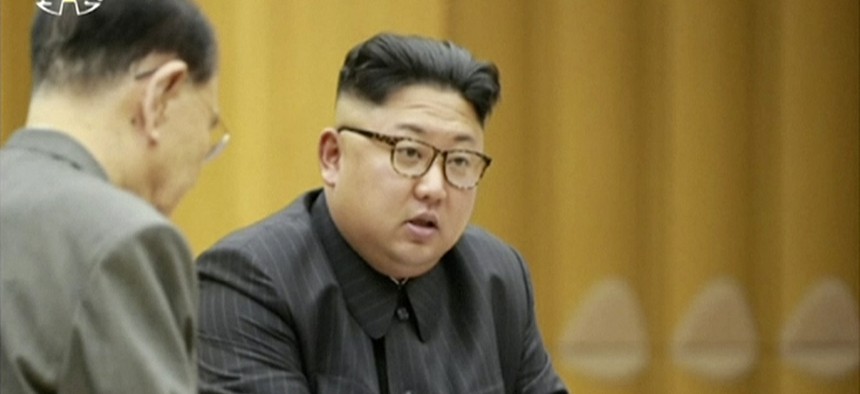
This image made from undated video of a news bulletin aired by North Korea's KRT on Sept. 3, 2017, North Korea's leader Kim Jong Un holds the Presidium of the Political Bureau of the Central Committee. North Korean state television said on Sunday, Sept. 3 KRT via AP
USAF General on Countering North Korea: ‘The Enemy Has Closed the Gap’
Various weapons meant to deter North Korea from developing nukes will arrive only in time to deter Kim from using them.
How badly did the United States underestimate the pace of North Korea’s missile development? Here’s Gen. Robin Rand, who leads Air Force Global Strike Command: “We’ve got to get humping,” he said. Rand rattled off a variety of programs and modernization efforts, such as the Ground-Based Midcourse Defense program — the 44 or so missiles buried in silos in Alaska and California; the new B-21 stealth bomber program; and the long-range standoff nuclear cruise missile. But in doing so, he acknowledged what has become painfully obvious to anyone watching developments out of North Korea, if largely unremarked upon by a government and military eager to reassure the public: The U.S. response is years behind where military leaders would like it to be.
“None of these systems that I just mentioned are projected to be fielded before the mid- to late 2020s,” Rand said at the Association of Old Crows conference in downtown Washington on Friday. “Some people say, ‘Just in time.’ I say, ‘Late to need.’”
The Hwasong-15 missile that the North Koreans launched last Wednesday is larger than previous iterations, with a secondary boost mechanism that enables it to carry a warhead some 8,100 miles. “Such a missile would have more than enough range to reach Washington, D.C., and in fact any part of the continental United States,” noted David Wright of the Union of Concerned Scientists.
The U.S. is in the midst of a massive effort to modernize the systems it might use to strike North Korean targets, in the hopes of deterring the Kim regime from using its new weapons. For Rand, the most important aspect of these is making sure that that strike weapons and interceptors can stand up to current North Korean anti-aircraft (and anti-interceptor) technology — in short, that they can survive the North Korean regime’s best efforts to take them out.
“The things we are doing in these new systems that are coming on, whether it’s long-range standoff [missiles,] the B-21, or the ground-based strategic deterrence, is to to make sure that there’s improvement over what we have currently in the survivability and reliability realm,” he said. “The enemy gets a big vote in are the weapons get to the target. That’s where a lot of things we’re doing are [going].”
But the long-range standoff missile is won’t be ready for manufacture until 2022. And the new Northrop Grumman B-21 Raider isn't slated to enter service until 2025.
As for those Alaska and California-based interceptors that are meant to protect the continental United States, researcher Joshua Pollack and others have pointed out that four must be launched to reach a very high — 97 percent — chance of knocking down each North Korean missile hurtling toward the United States. And firing multiple interceptors at one incoming rocket also won’t work if it turns out that that the poor reliability demonstrated in testing so far isn’t because of individual or manual errors but because there’s just something fundamentally wrong with the interceptors themselves.
All of those doubts predate the Hwasong-15, which has a nose large enough to carry decoys to throw off interceptors. The U.S. anticipated this and recently announced that it would accelerate the development of an interceptor that could take out multiple potential incoming warheads and decoys. But, here too, the solution won’t be available until 2025.
The U.S. is also working on a drone that can fire a laser at a North Korean missile just as it is taking off, when it’s easiest to hit. But the low-power laser demonstrator program also won’t be online until 2021.
All of this suggests that the U.S. underestimated the pace of North Korean technological development by five years or more. Until the new stuff comes online, the United States can improve its odds of countering North Korean missile launches by better predicting when they might occur — and then sabotaging them via cyber operations or something more exotic. This is perhaps the only area where rapid improvements in technology are working for the U.S. and not against it.
Constellations of microsatellites in low earth orbit, and very-high-resolution satellites, can help the U.S. keep a much more persistent watch over the Korean Peninsula. The U.S. is using the latest machine learning and artificial intelligence techniques, such as deep learning, to sift through that footage to gain a better sense of what the North Koreans might be up to.
“While we cannot address missile launch detection methods, NGA analysts use deep learning specifically to help establish patterns of life among large volumes of imagery in order to detect when that pattern changes,” a spokesperson from the National Geospatial-Intelligence Agency told Defense One.
In the meantime, the U.S. must settle for the more traditional definition of deterrence, which had less to do with curbing the development of nuclear weapons and everything to do with using them.
“Deterrence is hard to measure,” said Rand. “We’re not in conflict with them. To say deterrence isn’t working, I would take exception to that. For the last 60 years, I would say our deterrence has worked.”




